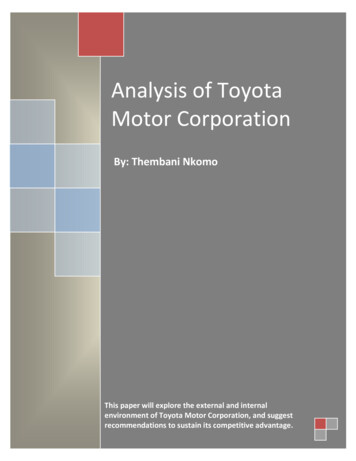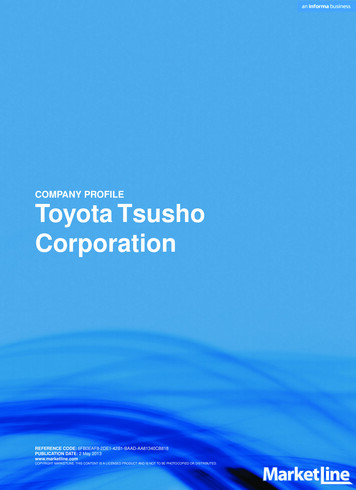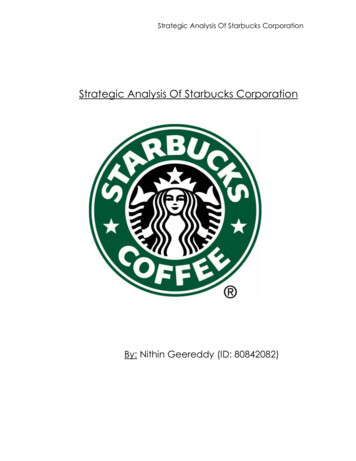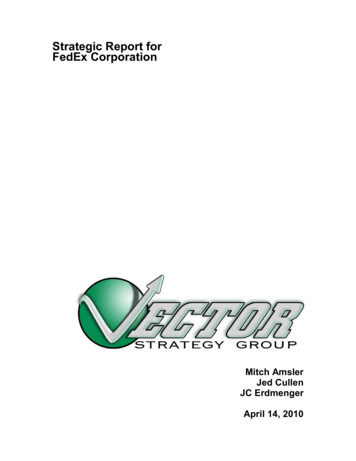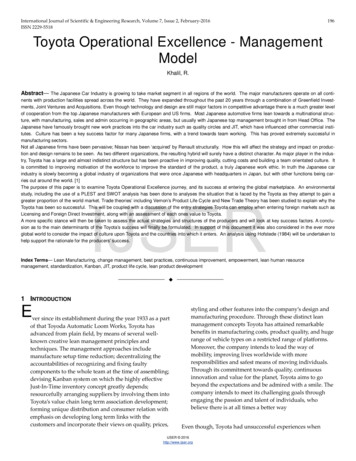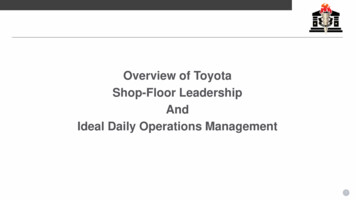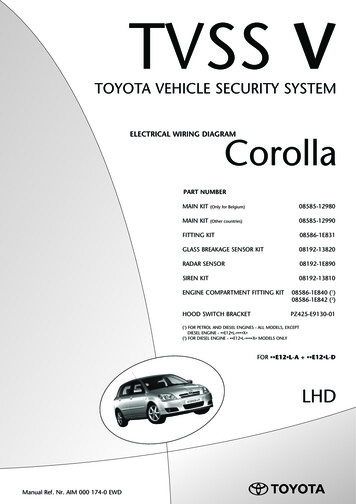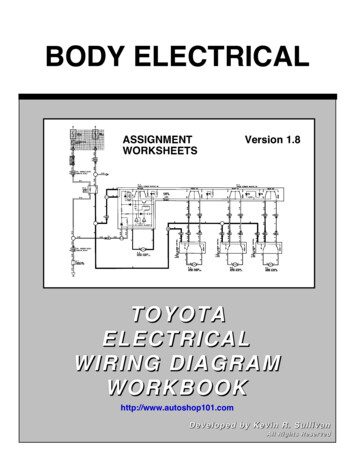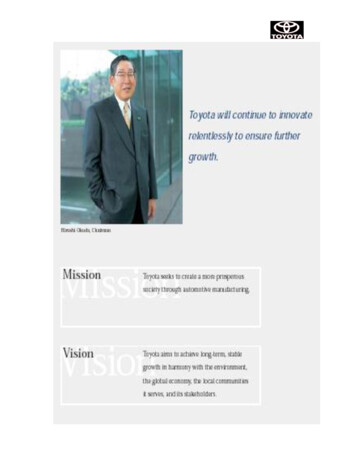
Transcription
Strategic ManagementOfToyota CorporationNAME:-M.ShanmugarajaROLL NO:-25027CLASS:-T.Y.B.B.ISUBBMITTE TO:Prof. Rahul Shah
IndexSr NoTopic1.Toyota Motors Introduction2.History of Toyota Corp3.Background of Toyota Kirloskar Pvt Ltd4.Products and services of Toyota5.Levels of Strategic management6.Key towards Business strategy7.Key towards strategic planning8.Strategic Management Process9.BCG Matrix10.7 „s McKinsey Model11.GE Matrix12.Structure Follow Strategy13.Grand Strategy14.Conclusion15.Recommendation
AcknowledgementI express our sincere thanks to our esteemed institutions “S.I.W.S” forthis opportunity given to us. I wish to express our deep sense andgratitude to Professor Rahul Shah. I also sincerely thanks to all ourprofessors and non-technique staff. They have been constant source ofinspiration completing the project.
1. Toyota Motor IntroductionToyota Motor Corporation is one of the world„s leading automakers,offering a full range of models, from mini vehicles to large trucks. Globalsales of its Toyota and Lexus brands, combined with those of Daihatsu andHino, totaled 6.78 million units in CY2003*. Besides its own 12 plants and11 manufacturing subsidiaries and affiliates in Japan, Toyota has 45manufacturing companies in 26 countries/locations, which produce Lexusand Toyota-brand vehicles and components. As of March 2003, Toyotaemploys 264,000 people worldwide (on a consolidated basis), and marketsvehicles in more than 140 countries. Automotive business, including salesfinance, accounts for more than 90% of the company's total sales, whichcame to a consolidated 16.05 trillion in the fiscal year to March 2003.Diversified operations include telecommunications, prefabricated housingand leisure boats.AmericaAmerican SamoaAustraliaBahrainBrunei DarussalamChinaFijiGuamHong Kong, siaNepalNew CaledoniaAfricaAsiaSaipanSamoaSaudi ArabiaSingaporeSolomon IslandsSri LankaTahitiTaiwanThailand
2. History of ToyotaThe history of Toyota, starts with the birth of founder Sakichi Toyoda. Ittraces the company's development through 1937 from when Toyota MotorCorporation was established to when the 2 millionth Prius hybrid was sold.1867 Birth of Sakichi Toyoda.1924 Sakichi Toyoda invents Toyoda Model G Automatic Loom.1929 Automatic-loom patent is sold to a British company.1930 Kiichiro Toyoda begins research on small gasoline-powered engine.1933Automobile Department is established at Toyoda Automatic LoomWorks, Ltd.1935 The Toyoda precepts are compiled.1936 The AA Sedan is completed.1937 Toyota Motor Co., Ltd. is established.1938 Honsha Plant begins production1950Company faces a financial crisis; Toyota Motor Sales Co., Ltd. isestablished.
1951 Suggestion System begins.1955The Toyopet Crown, Toyopet Master and Crown Deluxe arelaunched.1957The first prototypes of the Crown are exported to the United States;Toyota Motor Sales U.S.A., Inc. is established.1959 Motomachi Plant begins production.1962 Joint Declaration of Labor and Management is signed.1965 Toyota wins the Deming Application Prize for quality control.1966The Corolla is launched; business partnership with Hino Motors Ltd.begins.1967 Business partnership with Daihatsu Motor Co., Ltd. begins.1974 Toyota Foundation is established.
3. Background of Toyota Kirloskar Motor Pvt. LtdMr. H NakagawaManaging DirectorSandeep Singh, DMDDate Of EstablishmentChairmanVice ChairmanManaging DirectorDeputy MD'sDMD, CommercialPaid-In CapitalShareholdersMr. S Tomonaga, DMDMr. Shekar ViswanathanDMD, CommercialOctober 6, 1997Mr. Mitsuhiro SonodaMr. Vikram S KirloskarMr. H. NakagawaMr. Sandeep SinghMr. S. TomonagaMr. Shekar ViswanathanRs. 7 billionToyota Motor Corporation (89%equity)Kirloskar Group (11% equity)
4. Products of Toyota aAvensisEchoMR2SportsCamry Sportivo Corolla SportivoRav 44 W/DLandCruiser Prado LandCruiser 100LandCruiser 78 HiaceTown AceCommercialCoasterCelicaHiluxKluger
5. Levels of Strategic SS LEVELCONTROLFUNCTIONAL LEVELThere are three levels of the strategy management1. Corporate level :It describes the company‟s overall direction in terms of it generalattitude towards growth and management towards various business andproducts line.For e.g. The corporate strategy of toyota are cutting waste, listing specificadvice such as: “Cut down on the distance that things move throughoutthe plant.” Another example of this advice, representative of Toyota
strategic management and its attitude towards its workforce, is: “Utilisethe inherent talent of your workers.”2. Business level strategy:At this level the aggregated business strategies comes into picture .For ex. Toyota business strategies include the development of hybrid cars.Part of Toyota strategic planning is developing a premium position inhybrids in tune with present consumer values.3. Functional level strategies:This level of strategy includes all the 4 functional area ie marketing,finance, hr, operations. The organizations here take all major decisions inall the 4 functional areas. They make it a point to choose the mostappropriate strategy while appointing employees, allocating resources,arranging funds and initiating promotion techniques.
6. Key Towards Business strategySWOT Analysis is keys to business strategies used to evaluatethe Strengths, Weaknesses, Opportunitiesand Threatsinvolvedina business venture. It involves specifying the objective of the businessventure and identifying the internal and external factors that are favorableand unfavorable to achieving that objective.
SWOT analysis of Toyota MotorsSTRENGTHS1.Toyota has become the generic name in the Pakistan market.Whenever the company launches the new car in the market it hasalways the great support of the already market orientation so thecar introduced by it easily covers the introduction stage. Peoplehave a lot of trust for their name and this is why Toyota is theleader in automobile industry.2.Toyota has a great strength for its 2.OD car, Toyota is the hotselling diesel engine car in Pakistan and is the only companyoffering the diesel engine in this category of cars.3.The important edge over the company editors are the ampleavailability of the spare parts in the markets. The price of spareparts is comparatively low and availability all over the country hasproved to be beneficial for the company.4.Toyota is a financially strong company. This can be seen byanalysis of the financial reports of the previous years.5.Toyota vehicles have got a much stronger resale value than othercar in Pakistan. This is why people prefer to buy a Toyota.6.Toyota vehicles are made according to the Pakistani environment.No doubt the other cars are available but Toyota has an edgebecause it has learnt various conditions of the Pakistanenvironment and people. So new additions and changes areproving to be successful.7.Toyota has an edge over others because it is the only automobilecompany in Pakistan, while offers many variants of its vehicles.Also Toyota offered many variants of colors.8.Toyota is proud to have a successful team of competent managersand skilled workers. Extensive training have enabled theemployees to perform outstandingly.
9.Toyota is the only company having the most sophisticated networkof dealerships where customers are treated by professional dealers.There are seventeen dealers in Pakistan where sales, service andspare parts are offered, leading to convenience for the customers.WEAKNESSES1.There is some weakness in the case of ergonomic interior ofToyota corolla as well. The power steering is not speed sensitiveand the air conditioning system in severe heat is in-effective.Interior dimensions are less and heavy body and small enginesometimes create problems in hilly areas.2.There are some weaknesses in the dealership network. The dealerssometimes tend to deviate from the recommended course of actionand principles of Toyota. This results in customers complaintssometimes.3.The company is besieged with internal operating problems whichare not very serious. Because of dependency on Toyota‟sprinciples delivery of cars is done after 4-6 months. This isbecause CKD kits are ordered four months before and once theyarrive from Japan, assembly and delivery takes some more time.4.A lot of effort is pull into the sales forecasting because of thechanging political and economic scenarios. For this reasonsinventory has to be kept low.5.The company feels that one weakness is the changing policies ofthe government and also the 30% cash L/c margin. This has lead toan adverse environment.OPPORTUNITIES1.Export is a major opportunity for Toyota Indus Motors. Vehicleswere exported to Bangladesh just once in order to prove the plantcapacity and efficiency of the company. This should be startedagain.2.The contract with the government departments e.g. MotorwayPolice, Shaheen Force and the digniteries where corolla has anopportunity to deal with the business markets along with dealingin consumer markets.
3.Toyota can do better by focusing on segments much more thanpresently being done.4.Toyota should also try to lower its price of Corolla in the segmentwhere Honda city has penetrated.5.It can offer discounts to Government departments and largeorganizations on purchase of its vehicles in more quantities.6.Success of the manufacturing of Daihatsu coure is a majoropportunity for Toyota to excel further careful planning and theright time to launch the new car can prove to be a success.THREATS1.Even though Toyota enjoys the position of being the no.1automobile company, still it faces some threat from competitorsespecially Honda. Honda has adopted aggressive strategies forcapturing the market.2.Even though Toyota keeps a careful eye on the changing trends,still the changing customer needs and trends can prove to be athreat.3.A major threat is the changing political and economic scenarios ofPakistan. Changing government policies affect the company‟sperformance. Devaluation of rupee adverse shifts in foreignexchange rates, trade policies of government‟s is a threat.Moreover the company is threatened by the ongoing rate of 30%cash L/c margin.4.Import of re-conditioned cars is also considered as a threat for thecompany.5.The planned car manufacturing plants of Hyundai and Daewoo canprove to be tough competition for Toyota if they are successful.
7. Keys towards Strategic Planning1. Vision:Looking ahead to 2020, Toyota believes that re-examining the relationshipbetween nature and industry and pursuing harmony between monozukuri,people, and society in general, and nature is extremely important. Also, byseeking harmony between monozukuri and the cycles of nature, Toyota ishelping promote efforts toward finding a harmonious balance between thecycles of nature and the cycles of industry. We believe that it is our missionto tackle challenges in new fields in order to achieve this.2. Mission :To sustain profitable growth by providing the best customer experience anddealer support.3. Objective:The third key element is the explicitly stake the business in terms of theresults its needs and wants to achieve in a medium and long term.The main objective of Toyota is world domination, with regard to supplyingcars.4. Value:Toyota‟s first priority is to be a successful business and that means investingfor growth and balancing short term and long term.5. Goals:Goals are the specific interim or the ultimate time based measurement to beachieved. While implementing strategies in pursuit of companies objectives.The goal of the organization are set consistent , achievable and realistic. Asper survey‟s the present major goal of the organization is to adopt the besttechnology and appoint few more personnel that would bring efficiency inthe organization.
6. Programs:Last but not the least “program” plays a significant role in maintaining asmooth track within the organization. Toyota has got an implementation planfollowed up by the above strategic plan. Toyota performs a review and auditbefore launching or incorporating its product.7. Strategies:Strategies are the rules and guidelines, the vision, mission, objectives andgoals are sought to b achieved.The following are some of the key strategies adopted by Toyota:1. Base your management decisions on long term philosophies, even at theexpense of short term goals2. Create continuous process flow to bring problems to the surface3. Use pulls systems to avoid over production4. Level out the workload5. Build in a method to stop and fix problems when they are discovered, thisensures quality the first time6. Standardized tasks provide the foundation for continuous improvementand employee empowerment7. Use visual control so no problems are hidden8. Use only reliable, thoroughly tested technology that serves you people andprocesses9. Grow leaders who thoroughly understand the work, live the philosophyand can and do teach it to others
8. Strategic Management ProcessStrategic thinking provides the foundation of the strategic management. Byproviding an insight into the forces behind the intense competition, bydeveloping a sustaining competitive advantage based on organization corecompetency.It can be broadly divided into three phases:PHASE 1Strategic formulation:It is referred as a strategic plan1. Framing mission objectives:The first step adopted by Toyota was to frame the mission and objectivesfor the organization.For example: - The mission statement of Toyota is “To sustain profitablegrowth by providing the best customer experience and dealer support.”2. Analysis of the internal environment:After setting the mission and objectives the next step is to analyses theinternal environment.E.g.: Toyota is trying to improve the working condition so that theemployees in the organization can work peacefully.3. Analyze of external environment:The management conducts the analyses of th
06.10.1997 · SWOT analysis of Toyota Motors STRENGTHS 1. Toyota has become the generic name in the Pakistan market. Whenever the company launches the new car in the market it has always the great support of the already market orientation so the car introduced by it
